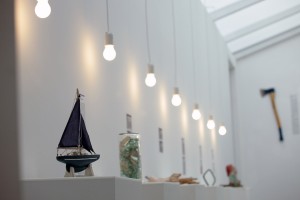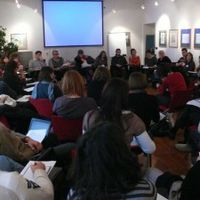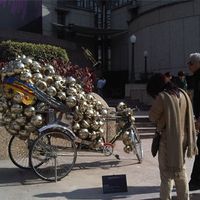Changes in contemporary art practices | 2 case studies from Asia and Europe

[caption id="attachment_10840" align="alignright" width="300" caption="Jatan, Museum of Memories. Recording Village festivity"]
How have changes in contemporary art practice affected institutionalized forms like the gallery and the museum? Drawing from emerging practices based on 2 case studies, India and Croatia this write up comments on history and contemporary art based institutions
Shifting nature of operational and functional aspects of art and culture make it interesting to look at current trends and practices, particularly those emerging in unique interstitial zones. Contemporary art as a term has been coined to describe modernism and modernist expression- particularly visual art. Since “contemporary” is also applied to the continuing story of humankind, the term is now rather useful to various continuing modalities that include both art production and art processes. Boundaries are being tested as the cultural sector moves towards reflective and collaborative practices that challenge modernist predecessor forms. Amongst contemporary art practitioners and gallery-based practices one sees a transition from traditionalist-modernist spaces to ‘unconventional’ art spaces. While negotiating this term “contemporary” these practice(s) have begun engaging community based content, participation and expression.
Art that built the nation
Independent and contemporary art has always had a tenuous relationship with the state. Nation-state favoritism has often always shone upon a close cousin of the gallery- the museum. In Europe and elsewhere during late 19th and early 20th centuries, the museum was endorsed with status and support. It is but natural that larger historic narratives, the dominant sort, get told and sold in a certain fashion.
[caption id="attachment_10841" align="alignright" width="300" caption="Jatan Museum of Memories 2005, Recording oral history of Rajhar family and community"]
 [/caption]
[/caption]Strangely though, South Asian, and more specifically, Indian response to museum culture over post independence decades of the 20th Century, has been one of tokenism. Until the neoliberal era began (in 1990s) the scale of investment in the white cube was not presented to a public sphere as matter of pride by the postcolonial Indian State, quite unlike its Euro-American counterparts. In India uniquely and in the city of Bangalore specifically, the state of museums has remained non-renewed and dated and the status on galleries stamped as ignored.
Other parts of the world have begun to question nationalist projections on to the institution of museums and are moving toward dismantling older structures that objectified and alienated, to ones more participative and interactive. India too begins to rather slowly awaken to cultural possibilities of communicative histories. These possibilities are however, primarily co-opted to support capitalist and nationalist forms. Museums for histories and learning stand ignored but the Indian state chooses to invest in a fleet of national galleries of modern art. Any investment from the State calls for high state of security and ‘gatedness’, ensuring selective inclusion of urban communities in Indian contemporary urban centers.
Despite its step motherly attitude to museums, the Indian state has seen the telling of its ancient and modern history as important. Viewing history through a colonially trained modernist framework, much of the imagination of how the state would see it would manifest as materializing grandiose visions of 20th century museum, only progressed in scale. In the neoliberal era, the next set of institutions that stand to be upgraded are the museums.
Museums with walls of memory and objects of emotion
[caption id="attachment_10842" align="alignright" width="300" caption="Museum of Broken Relationships, Croatia"]
 [/caption]
[/caption]Set in this backdrop of hegemonic historicizing of the public sphere, the work of India based Jatan Trust’s the Museum of Memory and that of the Croatian Museum of Broken relationships comprise much of this latter discussion. Oral histories, lived histories, ‘micro-histories’ of practice and personal histories have all been unrecognized, termed non-consequential or with any socio-political significance. Prevalent political practice has chosen to do this despite academics and practitioners’ (social workers, community workers, activists, artists) producing increasing evidence towards the necessity of these local, cultural and democratic processes in preserving and developing social space. Jatan trust, a media collective based in Madhya Pradesh, (India, http://jatantrust.org) has worked with 6 small districts and towns in the Hoshangabad district documenting micro-practices of culture, livelihood and social exchange. This audio-video documentation has been embedded in an interactive digital interface map. Available online as well as in the form of a mobile installation, Jatan’s museum of memory consists of a documentation of possibly disappearing practices, cultural markers in globalizing rural space, an archive and an interactive “museum”. In defining the museum thus, as both collective community memory, and as digital and mobile, the traditionalist museum as a symbol of dominant history is subverted and re-utilized.
In a similar context and from another part of the world, artist and art manager, Olinka Vistica from the Croatian Museum of Broken Relationships speaks of ways in which she tried to subvert the notion of museum. The project does this by reinstalling content that is personal and yet, with universal intrigue and appeal. The project challenges notions of valued and objectified art and artefact by focusing on the extremely personal- individual stories of romantic break-up. This highly individual context of memory projects heightened meaning on to objects that are relatively ordinary and everyday, commenting thus on the customary process of valuing collections.
[caption id="attachment_10843" align="alignright" width="300" caption="Museum of Broken Relationships, Croatia"]
 [/caption]
[/caption]Over a period of 30 years, from being an art installation to a touring exhibition in various spaces, the collection has now acquired museum status in the city of Zagreb, Croatia. Olinka Vistica speaks of the romantic “break-up” as a state that is strong and rich in introspective possibilities, possibilities denied within a global hectic society. She believes that the museum of broken relationships facilitates a rather uniquely personal as well as a socially cathartic transformation.
The museum, harnessing the power of personal loss- something that a human being is affected so strongly with, colors its objects with the ambiguity and the sensibility, facilitating heightened value due to identifiable emotional content. In that, it also subverts ascribing rising commercial value, as the objects taken out of their context of story are everyday objects with little worth.
Allowing a process of contribution, the museum adds on to it, the additional layer of participative contribution, coming more and more closer to its audience to form a relationship. Olinka Vistica invites her audience to come over to ask how the 700 odd collection of diverse everyday objects so personal can yet be universal in experience. How has the collection evolved across local communities, and from this personal and intimate sharing how does one read the universal?
Deepak Srinivasan is an artist, media practitioner, researcher and pedagogue, currently a core member of Maraa (www.maraa.in), a media & arts collective based in Bangalore and faculty at Srishti School of Art, Design and Technology, Bangalore (www.srishti.ac.in). After a Bachelor's degree in environmental sciences and an MS in neurobiology, his interests shifted to exploring the role of performance as method for trans-disciplinary inquiry. Since 2005, he has been training in performing arts and community theatre. Deepak’s experience in media comes from his days as content developer with Worldspace Satellite Radio. Media and art practice have become an emerging focus for Deepak and help to better understand the role of culture in emerging political negotiations and identities.
Similar content
posted on
15 Jun 2010
18 Feb 2011






